Semi-trailer truck
There are a wide variety of English-language terms for a semi-trailer truck, including: The main difference between tractor units in Europe and North America is that European models are cab over engine (COE, called "forward control" in the United Kingdom),[9] while the majority of North American trucks are "conventional" (called "normal control" or "bonneted" in the UK).Since 1996 Sweden and Finland formally won a final exemption from the European Economic Area rules with 60 tonne and 25.25-metre (83 ft) combinations.What stopped Sweden from adopting the same rules as the rest of Europe, when securing road safety, was the national importance of a competitive forestry industry.The mining company Boliden AB have a standing special permit for 76-tonne (75-long-ton; 84-short-ton) combinations on select routes between mines in the inland and the processing plant in Boliden, taking a 50-tonne (49-long-ton; 55-short-ton) load of ore. Volvo has a special permit for a 32 m (105 ft), steering B-trailer-trailer combination carrying two 12 m (40 ft) containers to and from Gothenburg harbour and the Volvo Trucks factory, all on the island of Hisingen.As the combination spreads its weight over more axles, braking distance, road wear and traffic safety is believed to be either the same or improved with the 90-tonne (89-long-ton; 99-short-ton) truck-trailer.In 2012, the Northland Mining company received permission for 90-tonne (89-long-ton; 99-short-ton) combinations with normal axle load (an extra dolly) for use on the 150 km (93 mi) Kaunisvaara-Svappavaara route, carrying iron ore.[17][18][19] As of 2015[update], the longest and heaviest truck in everyday use in Finland is operated by transport company Ketosen Kuljetus as part of a pilot project studying transport efficiency in the timber industry.The maximum permitted gross weight of a semi-trailer truck without the use of a Special Type General Order (STGO) is 44,000 kg (97,000 lb).Providing certain requirements are fulfilled, a Special Types General Order (STGO) allows for vehicles of any size or weight to travel on UK roads.[citation needed] In 2009, the operator Denby Transport designed and built a 83 ft long (25.25 m) B-Train (or B-Double) semi-trailer truck called the Denby Eco-Link to show the benefits of such a vehicle, which were a reduction in road accidents and result in fewer road deaths, a reduction in emissions due to the one tractor unit still being used and no further highway investment being required.This is based on the fact that for light but bulky goods such as toilet paper, plastic bottles, cereals and aluminum cans, conventional semi-trailer trucks run out of cargo space before they reach the weight limit.[citation needed] The vehicle was built after Denby Transport believed they had found a legal-loophole in the present UK law to allow the Eco-Link to be used on the public roads.[citation needed] The point of law reportedly hinged on the definition of a "towing implement", with Denby prepared to argue that the second trailer on the Eco-Link was one.Reportedly, private trials had also shown the Denby vehicle had a 20% shorter stopping distance than conventional semi-trailer trucks of the same weight, due to having extra axles.On 1 December 2009 Denby Transport were preparing to drive the Eco-Link on public roads, but this was cut short because the Police pulled the semi-trailer truck over as it left the gates in order to test it for its legality "to investigate any... offenses which may be found".The fifth-wheel trailer coupling on most tractor trucks is movable fore and aft, to allow adjustment in the weight distribution over its rear axle(s).With changes in the US to the maximum length of the combined vehicle, the cabover was largely phased out of North American over-the-road (long-haul) service by 2007.Cabovers were difficult to service; for a long time, the cab could not be lifted on its hinges to a full 90-degree forward tilt, severely limiting access to the front of the engine.[citation needed] Long combination vehicle types include: The US federal government, which only regulates the Interstate Highway System, does not set maximum length requirements (except on auto and boat transporters), only minimums.B-doubles are very common in all parts of Australia including state capitals and on major routes they outnumber single trailer configurations.[citation needed] Common combinations in New Zealand are a standard semi-trailer, a B-double, or a rigid towing vehicle pulling a trailer with a drawbar, with a maximum of nine axles.The truck trailer cannot move by itself because it only has wheels at the rear end: it requires a forward axle, provided by the towing engine, to carry half the load weight.This is a fail-safe design feature which ensures that if air pressure to either unit is lost, the vehicle will stop to a grinding halt, instead of continuing without brakes and becoming uncontrollable.This arrangement provides a secure connection but allows the couplers to break away without damaging the equipment if they are pulled, as may happen when the tractor and trailer are separated without first uncoupling the air lines.A ten-speed manual transmission, for example, is controlled via a six-slot H-box pattern, similar to that in five-speed cars — five forward and one reverse gear.On an automobile, the clutch pedal is depressed full stroke to the floor for every gear shift, to ensure the gearbox is disengaged from the engine.[46] Skirted trailers are often combined with Underrun Protection Systems (underride guards), greatly improving safety for passenger vehicles sharing the road.Public awareness of this safeguard was increased in the aftermath of the accident that killed actress Jayne Mansfield on 29 June 1967, when the car she was in hit the rear of a tractor-trailer, causing fatal head trauma.[57][58] In fact, for decades NHTSA has ignored credible scientific research on side underride guards and failed to take simple steps to stop these crashes.[61] In addition to safety benefits, these underride guards may improve fuel mileage by reducing air turbulence under the trailer at highway speeds.Some states (such as North Dakota) provide exemptions for farmers, allowing non-commercial license holders to operate semis within a certain air-mile radius of their reporting location.
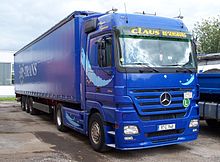


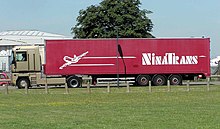




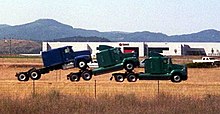



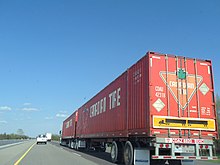
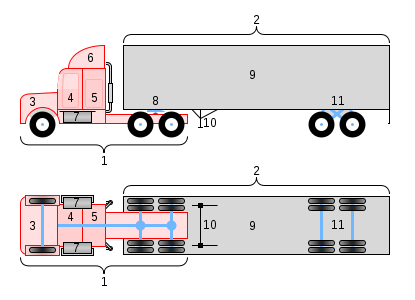
1. tractor unit
2. semi-trailer (detachable)
3. engine compartment
4. cabin
5. sleeper (not present in all trucks)
6. air dam (not present in all trucks)
7. fuel tanks
8. fifth wheel coupling
9. enclosed cargo space
10. landing gear – legs for when semi-trailer is detached
11. tandem axles





18 wheeler (disambiguation)Big Rig (disambiguation)tractorcab-overtractor unitsemi-trailersfreightfifth wheelAmerican EnglishBritish EnglishCanadian EnglishRenault MagnumEuropeNorth Americacab over engineUnited Kingdomstraight trucksarticulatedlicense platerigid truckspintle hitchBackingtimber trucksloader craneISO containerB-doubleswap bodySwedencut-to-lengthCEN unitBoliden ABBolidenGothenburg harbourVolvo TrucksHisingenNorrbottenEuropean route E4ÖverkalixPiteåDalslandBohuslänSkoghallKaunisvaaraSvappavaarapilot projectRenaultSilverstonegross weightkingpinDepartment for TransportB-TrainDenby Eco-LinkVehicle and Operator Services Agencydrive axlescabover enginecargo trailertandemmonikermisnomerLong combination vehicleSTAA doubleSTAA doublesNevadaCanadaInterstate Highway SystemwheelbaseRoad transport in AustraliaAustralianroad trainsturntableNorthern Territorycaboversprime moverKenworthroad trainSturt HighwayNZ Transport Agencydrive shaftdifferentialssemi-trailerenginefuel tanksfifth wheel couplingdry vanCar haulerIntermodal chassisDry bulkFlatbedHopper-BottomLowboyRefrigeratorReeferTankerking pintowing enginetruck trailerJackknifinghydraulicbrake fadefail-safegladhand connectorsrailroad carsengine brakingJake brakeexhaust brakenoise pollutionretardersmanual transmissionsmanual transmissionautomated manual transmissionsautomatic transmissionstransmissionsdrive axleautomobileconstant-mesh transmissiondouble-clutchingdiesel-electric transmissiongreenhouse gas emissionsTrailer skirtturbulentaerodynamic dragUnited States Environmental Protection AgencyJayne Mansfieldhead traumarear-end collisionwindshield
